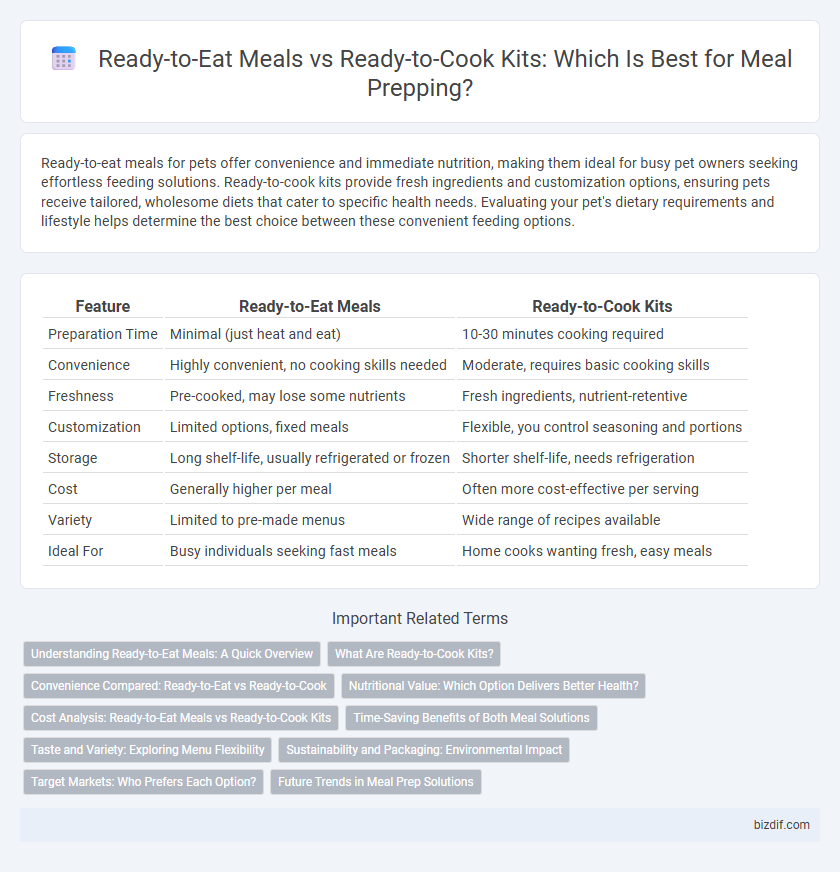Ready-to-eat meals for pets offer convenience and immediate nutrition, making them ideal for busy pet owners seeking effortless feeding solutions. Ready-to-cook kits provide fresh ingredients and customization options, ensuring pets receive tailored, wholesome diets that cater to specific health needs. Evaluating your pet's dietary requirements and lifestyle helps determine the best choice between these convenient feeding options.
Table of Comparison
| Feature | Ready-to-Eat Meals | Ready-to-Cook Kits |
|---|---|---|
| Preparation Time | Minimal (just heat and eat) | 10-30 minutes cooking required |
| Convenience | Highly convenient, no cooking skills needed | Moderate, requires basic cooking skills |
| Freshness | Pre-cooked, may lose some nutrients | Fresh ingredients, nutrient-retentive |
| Customization | Limited options, fixed meals | Flexible, you control seasoning and portions |
| Storage | Long shelf-life, usually refrigerated or frozen | Shorter shelf-life, needs refrigeration |
| Cost | Generally higher per meal | Often more cost-effective per serving |
| Variety | Limited to pre-made menus | Wide range of recipes available |
| Ideal For | Busy individuals seeking fast meals | Home cooks wanting fresh, easy meals |
Understanding Ready-to-Eat Meals: A Quick Overview
Ready-to-eat meals offer convenience by providing fully cooked and packaged dishes that require no preparation, making them ideal for quick consumption. These meals often come in portion-controlled packaging, preserving freshness and nutritional balance while saving time on cooking and cleanup. Understanding the benefits of ready-to-eat meals helps consumers make informed choices between instant nourishment and the interactive experience of ready-to-cook kits.
What Are Ready-to-Cook Kits?
Ready-to-cook kits provide pre-portioned ingredients and step-by-step recipes for quick meal preparation, combining convenience with culinary creativity. These kits reduce food waste by offering precise quantities, making them an eco-friendly choice compared to traditional grocery shopping. Popular meal kit services like Blue Apron and HelloFresh cater to various dietary preferences, including vegetarian, keto, and gluten-free options.
Convenience Compared: Ready-to-Eat vs Ready-to-Cook
Ready-to-eat meals offer maximum convenience by eliminating all cooking steps, ideal for busy individuals seeking quick nutrition without preparation time. Ready-to-cook kits provide pre-portioned ingredients and recipes that simplify meal preparation while retaining the experience and freshness of home-cooked dishes. Both options enhance convenience differently: ready-to-eat prioritizes speed, whereas ready-to-cook balances ease with culinary engagement.
Nutritional Value: Which Option Delivers Better Health?
Ready-to-eat meals often contain higher levels of preservatives, sodium, and added sugars, potentially compromising their nutritional value compared to ready-to-cook kits. Ready-to-cook kits generally provide fresher ingredients with fewer additives, allowing greater control over portion sizes and nutrient content. For optimal health benefits, choosing ready-to-cook kits supports a balanced intake of vitamins, minerals, and macronutrients essential for meal prepping.
Cost Analysis: Ready-to-Eat Meals vs Ready-to-Cook Kits
Ready-to-eat meals often carry a higher price per serving due to convenience, with costs ranging from $8 to $15 compared to $4 to $8 for ready-to-cook kits. Ready-to-cook kits provide fresh ingredients and recipes, reducing food waste and offering long-term savings for frequent meal prep enthusiasts. Cost efficiency in meal prepping depends on factors such as frequency, brand, and dietary preferences, with ready-to-cook kits generally offering better value for those willing to prepare meals.
Time-Saving Benefits of Both Meal Solutions
Ready-to-eat meals significantly reduce meal preparation time by eliminating cooking steps, making them ideal for quick consumption. Ready-to-cook kits save time on meal planning and ingredient shopping while still requiring some cooking, offering a balance between convenience and freshness. Both solutions streamline weekly meal routines, catering to busy lifestyles with minimal time investment.
Taste and Variety: Exploring Menu Flexibility
Ready-to-eat meals offer convenient, pre-cooked options with consistent taste profiles suited for quick consumption, often featuring limited variety per package. Ready-to-cook kits provide fresh ingredients and recipes that allow greater customization and experimentation with flavors, enhancing menu flexibility. Consumers seeking diverse culinary experiences tend to prefer cooking kits for their ability to tailor meals to personal taste preferences and dietary needs.
Sustainability and Packaging: Environmental Impact
Ready-to-eat meals often generate more single-use packaging waste, increasing environmental burdens compared to ready-to-cook kits, which typically use less plastic and encourage portion control, reducing food waste. Sustainable meal prepping favors recyclable or biodegradable packaging materials, minimizing landfill impact and lowering carbon footprints. Consumers prioritizing eco-friendly choices should consider meal kit options that promote reduced packaging waste and resource-efficient production methods.
Target Markets: Who Prefers Each Option?
Ready-to-eat meals cater primarily to busy professionals, students, and individuals seeking convenience without cooking time, appealing to those with limited culinary skills or time constraints. Ready-to-cook kits attract cooking enthusiasts and health-conscious consumers who desire fresh ingredients and the experience of meal preparation but want to save on grocery shopping and planning. Both target markets prioritize convenience, yet differ in their engagement level with cooking and dietary customization.
Future Trends in Meal Prep Solutions
Future meal prep solutions emphasize convenience and customization, combining the benefits of ready-to-eat meals with ready-to-cook kits through advanced packaging and sustainability initiatives. Innovations in nutrient preservation and AI-driven personalization are driving the development of meals tailored to individual dietary needs and lifestyles. Increased integration of plant-based and functional ingredients reflects the growing consumer demand for health-conscious and eco-friendly options.
Ready-to-eat meals vs Ready-to-cook kits Infographic

 bizdif.com
bizdif.com